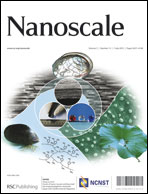Single ZnO nanotetrapod-based sensors for monitoring localized UV irradiation
Abstract
Single ZnO nanotetrapod-based sensors for monitoring localized UV irradiation were constructed with ohmic and Schottky contact characteristics. Localized UV irradiation at the third leg of the tetrapod was monitored by measuring the sensor's current response. Measurements of I–V performances and time-resolved current were conducted. The results demonstrate that localized UV irradiation can be detected in real time as electrical transport properties can be modulated by localized UV irradiation, and the higher the UV light power density gets, the larger the current response becomes, which is observed to be completely repeatable and reversible. Additionally, Schottky-contact type sensors clearly show a greater current response than ohmic-contact-type sensors, which further proved that Schottky-contact-type sensors are a better choice for detection in an irradiation environment. Two possible explanations are given for the phenomenon, including an electron transfer effect and a surface/interface effect on the band structure. The as-constructed sensors exhibit different sensitivities towards irradiation with various power densities, indicating that ZnO nanotetrapod-based sensors can be a promising candidate for detection in many areas including electron irradiation detection, ultraviolet irradiation monitoring, strain sensing, and complicated microenvironment observations such as biological cell inspection.


 Please wait while we load your content...
Please wait while we load your content...